Ancient Aliens on the Moon (30 page)
Read Ancient Aliens on the Moon Online
Authors: Mike Bara

Color enhanced image of Lunar Rover and Shorty crater. Note Orange soil, pink mountains and blue rock outcroppings. Colors are the result of prismatic light scattering from overhead glass ruins.
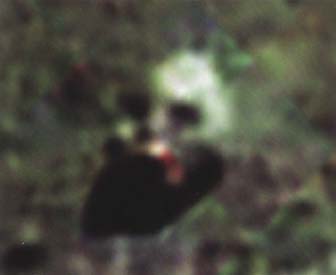
4-frame composite of ‘Data’s Head’ from Jack Schmitt’s panorama of Shorty crater. Red stripe appears to be painted on metallic surface of the artifact.

Orange soil near Shorty Crater. Note lavender rocks nearby and pink mountains in background. (NASA)
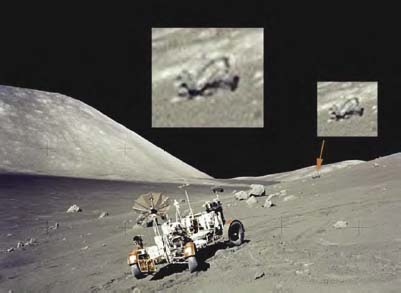
Image of mechanical device near the Lunar Rover from AS17-140-21409.
CLEMENTINE, TYCHO
AND THE FACTORY
B
efore we wrap up, I feel it’s important to look at some other research and some of the newer missions that have more recently returned to the Moon.
In 1994, the Naval Research Laboratory, the Ballistic Missile Defense Organization and NASA jointly sent a probe named Clementine to the Moon and took thousands of new images of our only satellite for the first time in decades. We’ll look at some of those images in a bit, but what was most provocative about Clementine was that “she” carried an excellent, high resolution digital imager which was state of the art for the time and could have afforded views in much greater definition than any of the 1960s and 70s Apollo era missions did. Unfortunately, in a move that brings up all of the “military intelligence” jokes I can think of, they didn’t get any hi-res images to speak of. At least, none that they’ve released to the public. The supposed reason? They left the lens cap on.
I’m not kidding.
The ostensible reason for this oversight was that the NRL had scheduled Clementine to rendezvous with an asteroid named 1620 Geographos, and they wanted to “save” the hi-res imager for that mission. As a result, most of the hi-res images available to the public which funded the mission are pitch black. However, there were some interesting medium resolution images taken, and a couple of them got me started on lunar anomaly hunting way back in the day.

Clementine image LBA5904z. 193. Bright star-like object at top is the planet Venus.
The first image was actually taken with Clementine’s low-resolution “star tracker” camera, which was used to navigate and position the spacecraft in its orbit around the Moon. On its 193
rd
orbit (April 1
st
, 1994, to be exact), Clementine was instructed to take an image of the lunar disk as the sun was receding behind it, in order to capture an image of the solar corona. It did that quite adequately. But it also captured something else; a stunning Transient Lunar Phenomena.
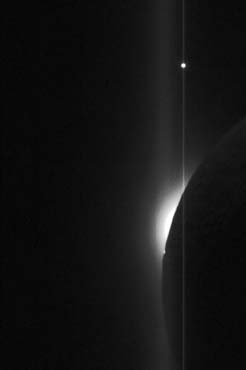
Close-up of Clementine TLP.
There, right on the edge of the lunar disk and exactly where you’d expect to see a bright specular reflection (if the transparent lunar dome model is correct) was a bona-fide, in your face TLP. Never again would anyone have to debate the reality of the phenomenon. A second image,
LBA5905z.l93, was taken one second later and confirmed the bright, glowing spec was not just an accident of the imager and that the flare of light lasted for a measureable period of time. Close-ups showed this strange reflection was right on the limb of the terminator, exactly where it would have to be if the glass structure model of the Moon was correct.
So if nothing else, Clementine had shown us that TLP’s do exist, are still happening and while they remain officially mysterious, this one’s appearance was exactly consistent with the glass lunar dome theory we’ve discussed in this book.
The truth is, I really didn’t expect (or get) much from Clementine. Its mission and instruments were classified, and after the shenanigans with the hi-res imager, I was not expecting much in terms of the data that would be offered to the public. But then one day in browsing some press release images of the crater Tycho, I got quite a surprise. Tycho has always intrigued me because it such a prominent feature on the lunar disk and it was the location of the Monolith in Stanley Kubrick’s
2001: A Space Odyssey.
So, given its storied fictional history, I decided to have a look at what was in the bottom of the crater. What I found not only freaked me out, it led to me eventually writing this book.
The image in question was a mosaic showing the central peak and north rim of the crater in three different wavelengths. The first two wavelengths showed a polygonal fracturing pattern in the floor of the crater, which is pretty normal for an assumed impact crater, and also reflected the different material compositions of rocks in the crater floor. But the third image, taken with Clementine’s Red/Green/Blue (visual) filter showed something quite different. There, mounted on the northeast rim of the crater and overlooking the central peak was some really weird looking stuff.

Clementine composite image of Tycho crater.
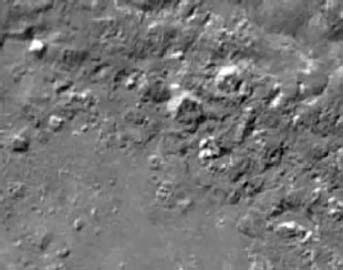
The Tycho Village.
My eye was caught by them because they had completely reflective properties than the surrounding terrain, standing out as bright white reflectivity in the false-color image produced by NASA. But it was also their shapes. They looked a whole lot like a pyramid, a couple of buildings and some heavy equipment.
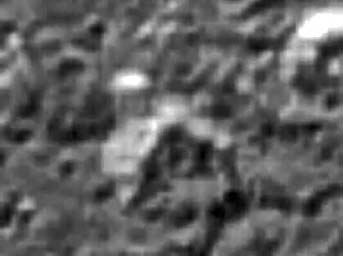
The Chalet.
For comparison purposes, I labeled these objects the “Pyramid,” the “Chalet,” the “Geo-dome,” the “Longhorn” and the “Backhoe,” and I called the whole area the “Village.” This does not mean that I am suggesting that these are in fact a backhoe, chalets, or a true pyramid. Remember, Tycho is over 65 miles across, so whatever these objects are they’re immense. In fact they are far too big to likely be what I have labeled them as. However, all these objects stand out based on their brightness relative to the surrounding terrain, their unusual geometric shapes, and their proximity to each other.
This object I dubbed the “Chalet,” looks somewhat like an A-frame building. Note that it appears to form fit on the left hand side matching the terraced terrain. The roof is also far brighter than the surrounding ground, indicating it is made of a different material. The roof also seems to overhang the flat faced supporting structure, and dark, regularly spaced “windows” are visible in a pattern on the front face. The “chimney” has several dark vertical striations, hinting at some sort of venting system. They are almost certainly not image artifacts, as they end where the chimney meets the roof. The chimney also appears to have a domed tip with a flange.